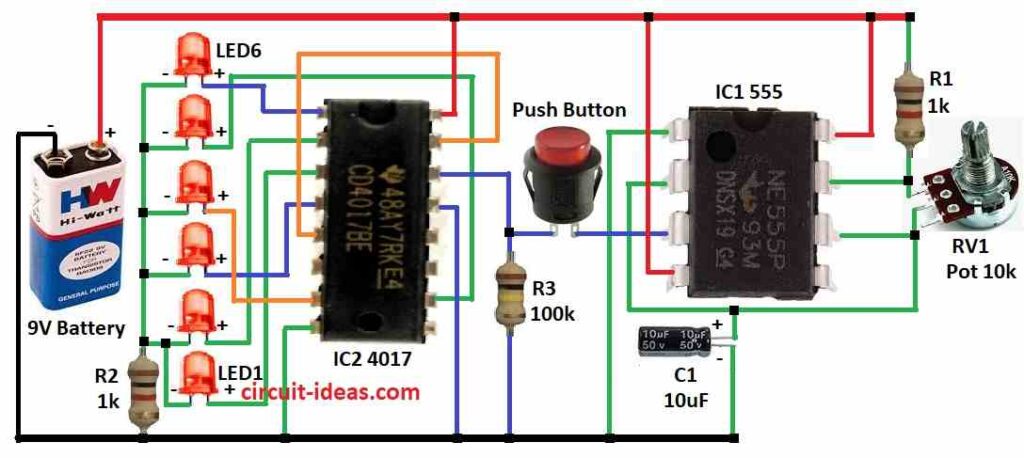Digital Dice Circuit is small electronic like thing.
It work like real dice and shows number from 1 to 6.
It uses lights and buttons which is no need to throw.
This circuit is good for games and fun.
Circuit Working:

Parts List:
| Component Type | Value | Quantity |
|---|---|---|
| Resistors (All resistors are 1/4 watt) | 1k | 2 |
| 100k | 1 | |
| Potentiometer 10k | 1 | |
| Capacitors | Electrolytic 10μF 25V | 1 |
| Semiconductors | IC 555 | 1 |
| IC 4017 | 1 | |
| LEDs 5mm 20mA | 6 | |
| Push button | 1 | |
| 9V Battery | 1 |
When playing games like snake and ladder the normal dice can get bad or unfair after long time.
Digital dice is better and more fair.
It uses electric parts but with no cheating.
Main parts are 4017 and 555 timer IC.
There are 6 LEDs with each from number 1 to 6.
When button is pressed LEDs blink fast one by one.
When button is released one LED stays ON that is the number rolled.
Example: if LED 5 stays ON then number 5 is rolled.
4017 IC checks which LED is ON.
555 timer controls how fast LEDs blink.
A part called potentiometer RV1 can change the speed of blinking.
More speed then faster LED blinking.
There is a formula to find frequency of 555 timer.
We keep frequency which is very high so no cheating.
We can turn potentiometer to change this speed.
Formulas:
The digital dice uses 555 IC in astable mode to make timing pulses.
This formula helps find how fast it works:
F = 1.44 / (R1 + 2 × RV1) × C1
where:
- F is the frequency and how fast LEDs blink
- R1 is fixed resistor
- RV1 is variable resistor that is potentiometer which we can turn
- C1 is capacitor and it gives the timing with the resistance.
- R1 + 2 × RV1 means total resistance.
This formula shows how 555 IC makes square wave signals.
Changing R1, RV1 or C1 changes the speed of LED blinking.
This is important to control how the digital dice works.
How to Build:
To build a Digital Dice Circuit we need to follow the below mentioned components connections process:
IC 555 Connections:
- Pin 1 connects to ground
- Pin 2 connect to pin 6
- Pin 3 connects one leg of push button
- Pin 4 connects to 9V positive
- Pin 6 connects to one leg of 10k potentiometer
- Pin 7 connects to other leg of 10k potentiometer
- Pin 8 connects to 9V positive
- Pin 2 connects to one side of capacitor C1 and other side of C1 and ground
- R1 connects between 9V positive and pin 7
IC 4017 Connections:
- Pin 1 connects to LED 6 anode
- Pin 2 connects to LED 2 anode
- Pin 3 connects to LED 1 anode
- Pin 4 connects to LED 3 anode
- Pin 5 connects to pin 15
- Pin 7 connects to LED 4 anode
- Pin 8 connects to ground
- Pin 10 connects to LED 5 anode
- Pin 13 connects to ground
- Pin 14 connects to push button
- Pin 16 connects to 9V positive
LED Cathodes:
- LED 2, 3, 4, 5, 6 cathodes connects to ground through R2
- LED 1 cathode join with LED 2 cathode
Safety Tips:
- Handle parts carefully
- Use correct tools
- Check all wires before turning ON
- If confused ask help from expert
Conclusion:
Digital Dice Circuit give random number like real dice.
It is fun and fair.
Build our own with simple parts and show the skills.
Be safe and enjoy learning electronics!
Leave a Reply